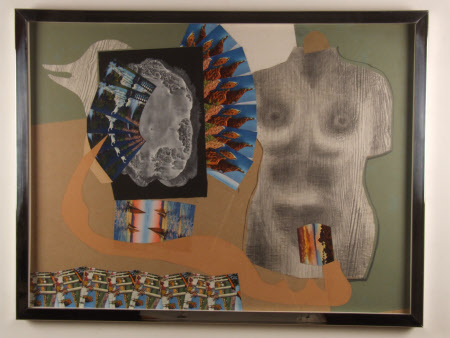The Real Woman
Sir Roland Penrose (London 1900 - East Sussex 1984)
Category
Art / Drawings and watercolours
Date
1937
Materials
Collage, watercolour and pencil with frottage on board
Measurements
749 x 1002 mm
Place of origin
England
Order this imageCollection
2 Willow Road, London
NT 112457
Summary
Collage, watercolour and pencil with frottage on board, The Real Woman, Roland Penrose (London 1900 - East Sussex 1984), 1937. A collage with picture postcards and frottage pieces, bird on left and woman's torso on right. Within a chromed metal frame and glazed.
Full description
This collage was made by artist, writer on art, poet and collector Roland Penrose in the summer of 1937 in Mougins in the south of France. He had travelled there with photographer Lee Miller, painters Max Ernst, Leonora Carrington and Man Ray, and surrealist poets Paul Eluard and his wife Nusch. Pablo Picasso and Dora Maar were also staying at the hotel. Penrose and Lee had met earlier that year in Paris and begun a relationship. Photographs taken by Miller from the end of their bed in Mougins show Penrose experimenting with a similar collage to this, using colourful postcards of the local area spliced together in a vibrant pattern (Lee Miller Archive). Collage would form an important part of his practice for the remainder of the 1930s. Penrose had instigated the International Surrealist Exhibition at the New Burlington Galleries in 1936, exposing a large British public to Surrealist techniques like collage and ‘frottage’ as way of expressing and exploring subconscious impulses. This work incorporates both. ‘Frottage’ is the French word for ‘rubbing’ and had been developed by Ernst in the 1920s. Paper or canvas is placed over a grainy surface and rubbed with a crayon, charcoal or soft pencil to create chance effects. Here, Penrose has used the technique to work up a study of Miller’s naked torso, using the texture of a wooden surface to create, and play against, the contours of her body. The strange shading of Miller’s torso, in which shadow and highlights appear to have been partially reversed, is reminiscent of solarised photography – a further Surrealist technique pioneered by Miller herself in her collaborations with photographer Man Ray in 1920s Paris. The title ‘The Real Woman’ is the artist’s own. Its meaning is not obvious but may be related to Lee’s only film rôle. She played a classical statue that comes to life - becomes a real woman - in Jean Cocteau’s Surrealist 'Le Sang d'un poète' (The Blood of a Poet) in 1932. That statue first appears without arms to uncanny effect, somewhat reminiscent of the torso in this collage, disturbingly divided from Lee’s head and limbs. Ernő and Ursula Goldfinger acquired The Real Woman in c.1937-40. Ernő and Miller had met at the Parisian theatre school of Ladislas Medgyes the 1920s - he a teacher, she a student. The Goldfingers probably already knew Penrose by the time he moved from Paris to London in 1936, where he socialised in overlapping circles and then settled at 21 Downshire Hill In Hampstead, not far from their flat in Berthold Lubetkin’s Highpoint I in Highgate. Once Miller had moved in with Penrose in 1939, and 2 Willow Road was completed round the corner from Downshire Hill that same year, the two couples became close neighbours. The Goldfingers offered Penrose one of the two houses adjoining 2 Willow Road, built as a return on their investment in the development. He refused because his elegant Georgian house was more to his taste, and because the large windows of the modernist terrace did not afford him enough hanging space for his art collection. When the Goldfingers held a selling exhibition of modern art at 2 Willow Road in June 1942 to raise money for the 'Aid to Russia' Fund of the National Council of Labour under the auspices of the Association of Architects, Surveyors and Technical Assistants, Penrose contributed two pictures, 'Black Music' and 'Orchestra, 1940'. The Real Woman formed part of what was becoming one of the most important Surrealist art collections in the United Kingdom, joining works that the Goldfingers had already acquired from Ernst, another friend. They would come to own at least one photograph by Miller. (John Chu, 2025)
Provenance
Acquired by Ernö Goldfinger and Ursula Ruth Blackwell, also known as Mrs Ernö Goldfinger between 1937-40. Purchased by the National Trust in 1994 with support from the Art Fund, the Elephant Trust, and other charitable foundations and private donors.
Credit line
2 Willow Road, The Ernö Goldfinger Collection (National Trust)
Makers and roles
Sir Roland Penrose (London 1900 - East Sussex 1984), artist
Exhibition history
Encounters with the 1930’s , Museo Nacional Centro de Arte Reina Sofía, Madrid, 2012 - 2013
